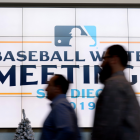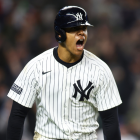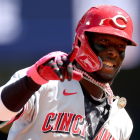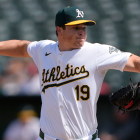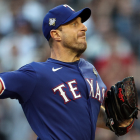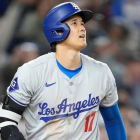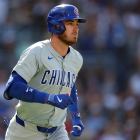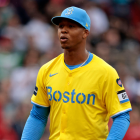
Baseball's annual Winter Meetings began in earnest on Monday and will run through Thursday. The tradition of the Winter Meetings dates back roughly a century, and some would surely argue that it's an outdated format, what with the decreasing importance of face-to-face interactions when it comes to Doing Business. In some ways, this year's baseball hootenanny/gathering of nerdy eagles will put that theory to the test.
That's because, owing to the current COVID-19 pandemic, the 2020 Winter Meetings will be entirely virtual. That said, buried within that unique medium are the usual hallmarks of the Winter Meetings. To set the scene for all that's to come, let's spelunk through the possibilities of the next via days and do so FAQ-style. Take it away, imaginary interlocutor …
1. What are the Winter Meetings, anyway?
In Decembers that aren't compromised by a pandemic, team execs, player agents, media, job seekers, and even a few players caucus in a hotel located in places like Las Vegas, San Diego, Dallas, Nashville, and New Orleans. The idea is to interface and lay the necessary groundwork for offseason trades and free agent signings. Very often, those trades and free agent signings are consummated during the Winter Meetings, and things conclude with the Rule 5 Draft. Time was when gathering in person for such matters was a necessity. However, in the age of World Wide Dial-Up Internet all of this probably isn't strictly necessary. That said, there's power in tradition, and people enjoy drinking in hotel lobbies.
2. You said this year's meetings are virtual?
Indeed. In late October, MLB announced that this year's Winter Meetings, which had been scheduled for Dallas, would not be conducted in person, because of COVID. The same decision was made for the owners' meetings, which were scheduled for November. Instead, in the words of the MLB press release, "the agendas of both meetings will be conducted remotely as necessary."
Presumably, that means zoom calls, conference calls, and the like for official business. As for discussions regarding free agent signings and trades, that will presumably be done via phone call and text, which is usually how those things go, anyway.
In addition to concerns about the pandemic, the costs of renting out hotel rooms and convention space were probably a consideration given the current financial situation in MLB.
3. Will we see any major signings?
This is unknowable, but it's possible that one or more of the leading free agents from the 2020-21 class -- Trevor Bauer, J.T. Realmuto, George Springer, DJ LeMahieu, and Marcell Ozuna -- will forge an agreement this week. We've already seen significant activity on the starting pitcher front, so perhaps that sub-market will continue to develop ahead of the others. Speaking of which, the best non-Bauer starting moundsman available for hire include Masahiro Tanaka, James Paxton, Jake Odorizzi, Adam Wainwright, Taijuan Walker, and Corey Kluber. As for hitters, the market for their services may be hindered by uncertainty over the status of the DH rule in the National League for 2021.
For more MLB hot stove talk, check out Fantasy Baseball Today, where the crew breaks down the best destinations for the top free agents.
4. Any chance they sort out the DH situation?
It's possible, given the general atmosphere of discussion and engagement, and theoretically it should be easy to sort out. To recap, during the abbreviated 2020 season the National League employed the DH in NL-versus-NL games for the first time in MLB history. That was to simplify things for the COVID-compromised season and lessen the risk of injury for NL pitchers. For 2021, however, the matter is unsettled. Obviously, this has a bearing on how NL teams make their offseason decisions -- the DH in the NL means that teams may want to add an impact bat. As our own Matt Snyder has written, this really should've been figured out before now, and the fact that it hasn't is probably contributing to the slow pace of the offseason insofar as free agent hitters are concerned. In particular, this will have bearing on the markets for Ozuna and Nelson Cruz, among others.
The Players' Association likely favors the DH in the NL, as it theoretically means additional high-paying and in some instances career-extending jobs for hitters. NL baseball ops people likely want the DH, too, as it allows easier use of bat-only players (of which there's always an abundance). Owners, though, may believe implementation of the DH in the NL should require some kind of give-back from the players. That could explain the hold-up. Whatever the specifics of this belated decision, MLB would do well to figure it out right away -- i.e., this week.
5. What about blockbuster trades?
Here's another slow-growing tentacle of the offseason. The rumors are out there, as star or near-star names like Francisco Lindor, Nolan Arenado, Kris Bryant, Blake Snell, Josh Hader, Lance Lynn, and Joey Gallo seem like realistic possibilities to be moved. The common thread is that all these guys all have relatively significant salary commitments for 2021 and in some cases well beyond 2021. The issue is that so many teams are in "austerity mode" right now after the financial hit of 2020. To be sure, MLB and its constituent franchises are almost certainly exaggerating the scale of their losses, but owners will take advantage of any rationale to avoid investing in the on-field product.
With so many teams looking to shed salary commitments -- and thus unwilling to assume salary commitments -- the "supply" side of the trade market could be pretty flooded. As always, teams trading valuable, high-salary veterans can improve the haul of players they get in return by kicking in cash, but this year teams may be unwilling to do that. That, in turn, means teams willing to improve their rosters via trade may be able to get a star-caliber player at a modest return in terms of prospects. That said, the limited number of teams that boast such a willingness right now may keep the trade market on ice for the time being. It's of course possible that the 2020 Winter Meetings will occasion a headline-grabbing swap, but the guess here is that those things don't happen until later in the winter.
6. Will the Cohen-era Mets make their first big acquisition?
New Mets boss Steve Cohen seems to be the rare MLB owner who grasps that winning baseball games -- and eventually the World Series -- is the entire point. He's promised to invest in the payroll at levels befitting a team that shares the largest media market in the Western Hemisphere, which is something that hasn't happened in a long time in Queens. Cohen still doesn't have his heads of baseball ops in place just yet, but if there's a deal to be struck that likely won't stop him -- especially with Sandy Alderson already back in the fold. If there's a team likely to be the "pace car" for offseason player movement and work against the trend of retrenchment, then it's probably Cohen's Mets. Their efforts to contend in 2021 (and beyond) could be heavily advanced this week.
7. Will Scott Boras hold court as usual?
One of the highlights of the Winter Meetings -- or lowlights if you're one of those who detests the agent in question for merely being very good at his job -- is when Scott Boras strolls into the hotel lobby of note and is promptly thronged upon by assembled media. He comes armed with quips and assessments of the developing market, and often his remarks are calculated to get under the skin of team owners and their abiding valet, commissioner Rob Manfred. If nothing else, it's quality entertainment, often in the service of getting Boras' clients the biggest deals possible. This time around, Boras isn't representing his usual grade of free agent, but he'll still be a prominent figure in the offseason. Perhaps he'll deign to partake in a virtual media scrum of some kind. If he does, then this simulacrum of the Winter Meetings will be the better for it.
8. What's a Rule 5 Draft, and why should I care?
As noted above, the Winter Meetings each year occasions something called the Rule 5 Draft. Basically, it's a draft of current minor leaguers who have yet to be added to their respective 40-man rosters in a manner timely enough to guarantee that their parent club maintains control of them. (There's also a minor-league portion of the Rule 5 Draft, but for these purposes we're talking about the major-league portion.)
Players not on the 40-man who were signed at age 18 or younger and have played professionally for at least five seasons are eligible to be selected. As well, players who signed at age 19 or younger and have played in the pros for four or more seasons without being added to the 40-man can also be drafted. Teams making Rule 5 selections must pay $100,000 to the player's former team, and that player must remain on the active 26-man roster for the entirety of the upcoming season in order to stick with the team that drafted him. If that doesn't happen, the player is returned to his former team.
While the success rate of Rule 5 picks is fairly low, teams occasionally hit the jackpot. In recent years, the likes of Johan Santana, Shane Victorino, Dan Uggla, Josh Hamilton, and Joakim Soria have been picked in the Rule 5 Draft. CBS Sports' R.J. Anderson has 17 names to watch ahead of this year's Rule 5 Draft.
9. Any other offseason subplots to follow this week?
Sho nuff. One thing to watch is what becomes of the "middle class" of free agents. Recent offseasons have been pretty tough on this demographic, and the 2020-21 offseason could take this trend to new extremes. Teams increasingly look within to find average to average-ish production, and often that's what the mid-grade free agents offer. Teams these days just aren't willing to pay a premium for that. This year, those pressures on the middle are heightened by the rich non-tender market. Non-tendered players are now themselves free agents, but they're not the "willing" free agents like those who have entered the market after accruing six years of MLB service time. Now that all of those non-tenders -- some of them very useful players -- have flooded the market, those free agents outside the top 10 could feel the squeeze. If we see one of those free agents sign for a surprisingly low figure during the Winter Meetings, then that could be a harbinger of things to come for the middle-dwellers.
10. Will this mark the end of the Winter Meetings as we know it?
That seems quite possible. Even before 2020, some argued that the Winter Meetings were anachronistic, and if the virtual addition goes off without a hitch and doesn't negatively affect the course of the remainder of the offseason, then it can be plausibly argued that we don't need this stuff anymore. With MLB increasingly prioritizing cost-cutting, the Winter Meetings could become another casualty of that approach. Call it a strong maybe.
11. What's the next big date on the offseason calendar?
A glance at our 2020-21 offseason calendar reveals that after the Winter Meetings the next big date is Jan. 15. That fine winter day marks the deadline for players and teams to exchange arbitration figures. It also marks the start of the international signing period.
12. Any parting words?
No.













